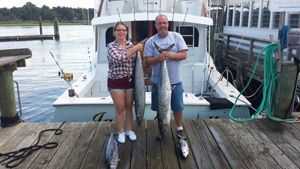
[dropcap]T[/dropcap]emps are cooling down, there is a lot less humidity and it is finally starting to “feel” right. Summer is finally gone and the kids are back in school, October is here and the wahoo fishing is going to be awesome! We have a world class wahoo fishery that occurs every year off the Crystal Coast. You have the opportunity to catch several fish, but also a good chance to catch a “wahoo of a lifetime” if you are lucky enough. The fish began showing up early again this year as they have the last couple of years, and as expected their numbers are steadily picking up as we have worked our way through September. Once we get on into October we should be wide open.
As the hot weather moves on and the hot water finally recedes out away from the beaches we will begin to see better defined offshore temperature breaks to fish on. The bait should begin to stack up on traditional spots, and also most good bottom structure occurring near a temperature break. Now is the time to really study your satellite information to find the best breaks in the best places. I say it every month, but only because it’s true – find the bait and you will find the fish! I generally like to start looking around 20-30 fathoms and work my way out a little deeper if necessary, but usually do not go past about 60 fathom. I don’t like over running the fish and I want to get my baits in the water as early as possible, especially when wahoo fishing. Everybody has their favorite spot for whatever reason but these fish can be found all up and down the line provided you find the right water. Key factor, all these fish have tails – they swim all day every day so they are not always at your “secret spot”.
Most days in the fall your planer rod and maybe your shotgun rig will get most if not all the action. The key to wahoo fishing is getting bait down deeper into the water which is why a planer rod is such a crucial tool. Yes, there are other ways that will work, but none will touch the proven effectiveness of a properly setup planer rod. You have to watch it like a hawk and check it frequently, and be ready to immediately jig that line if he hits it and misses. While doing that make sure someone is jigging on the shotgun rod as they will often see that erratic action when exiting the spread (after a short strike) and come back to grab an easy meal. We all have favorite colors/rigs and they will most all work, just make sure it is rigged on a nice long length of #9 piano wire as mono is a waste of time and money here in the fall. Keep your eyes watching the spread, it is not uncommon to find a sailfish sneaking around back there this time of year. Blackfin tuna and an occasional mahi may show up also. Any of these fish will bite that wire rigged bait!
Last couple of things I am compelled to mention – weather and sharp teeth. Fall weather is unpredictable and can switch the game up quickly, you need to have as good an idea as possible what the winds are going to do and be prepared to head on in early if you are in a small boat. A wahoo has a mouth full of razor sharp teeth – A friend of mine, an experienced mate, recently got airlifted from offshore and ended up with 130+ stitches due to wahoo teeth. These things can inflict VERY serious damage, even life threatening if you can’t get in fast enough. BE CAREFUL!
Watch the weather, check your satellite shots, rig your baits and make sure you have very sharp hooks – it’s time to get offshore and catch some wahoo. There is a lot of meat that comes off of each fish, please don’t keep more than you need just to let it get freezer burn and get tossed in the trash. Take your boat or charter one of us in the Morehead charter fleet – get yourself offshore because October is wahoo fishing at its finest!
Captain Troy Pate
[easy-social-share]
